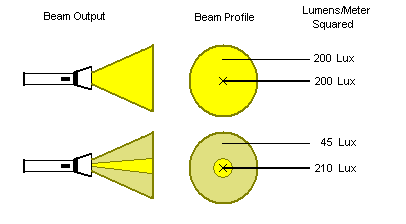|
Throughout
the reviews pages of this site, you will notice that we include
Lux (technically: lumens/meter²) output for the light.
Please bear with me through this explanation. It is fairly
important that you understand what this means before you base
your buying decisions on this one measurement.
Also,
let me mention that some manufacturers use "Candlepower"
or "Foot-candles" to measure the output of their
lights. Those measurements are subject to the same problems
I mention below for Lux.
There
are some quirks with the LUX
data that you should be aware of. The reading for Lux
is taken
only at the very center of the beam. This means that you
could potentially have a light with 1 tiny LED that has
all of its light focused to a laser-like beam that may read
higher than a 5 watt incandescent that has a broad flood-like
beam. The incandescent obviously puts out more light overall,
but the LED can send its light out farther ("throw")
since it is so tightly focused and as a result has a higher
Lux reading.
What
Lux really
tells is the "throw" of the light, or how good
it is at projecting light over a distance, NOT overall brightness
or quantity of light produced.
Lux
readings are strongly affected by the reflector and lens
design. When comparing lights against one another, the Lux
numbers represent how much light is hitting the target in
a narrow cylindrical area and does not represent the amount
of light surrounding that area. For example, a 3-D Maglight
has a higher Lux than
a Surefire E2, but that is because I can focus the Maglight
to a tight beam with little or no "spill light"
out to the sides. The E2, however, puts out more light overall
with a soft beam and wide, bright flood.
Here's
a good example: Here are 2 lights, both with a 200 Lux reading:

Note
how the top light puts out more light overall, but yet has
the same reading as the narrow focused light on the bottom.
This is because the bottom light focused all of its light
into a narrow, tight beam. Which is the better light? You
can't tell just based on the Lux reading.
Likewise,
we could have the following happen:

Here
we have the top light producing a nice 200 Lux flood over
the entire area of the beam. The light below produces MORE
Lux at the beam center (210), yet produces only 45 Lux at
the beam periphery. The top flashlight produces more light
overall, yet the bottom light receives a higher Lux
reading
and will light up a target at a slighter longer distance
with the narrow, brighter, part of the beam. If I only bought
the light based on the Lux reading, I may be very disappointed.
The moral
of the story is: don't base your purchase decision on one
factor such as Lux. Be sure to look at the beamshot target
included with each review to see the spread of the light beam
and the dropoff in intensity around its edges.
For more
information on Lumens, Lux, Candela, and Candle Power, I can
refer you to this
PDF file for help in that area. Enjoy!
|



